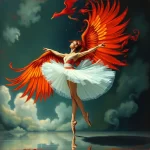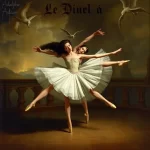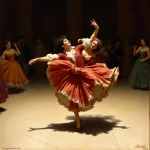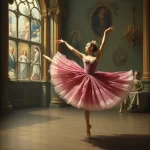Ballet: The Firebird (Igor Stravinsky, 1910)

Introduction
Ballet: The Firebird, composed by Igor Stravinsky in 1910, is a seminal work in the world of ballet. This one-act ballet was choreographed by Michel Fokine and premiered on June 25, 1910, at the Théâtre National de l’Opéra in Paris. The ballet is based on Russian folklore and tells the story of Prince Ivan, who captures a magical Firebird and is subsequently drawn into a battle against the evil sorcerer Kashchei. The Firebird’s assistance ultimately leads to the sorcerer’s defeat and the liberation of enchanted creatures.
Historical Background
Creation and Development
The Firebird was created during a period of significant artistic innovation and cultural exchange in early 20th-century Europe. The Ballets Russes, led by impresario Sergei Diaghilev, sought to bring Russian art and culture to Western Europe. Diaghilev commissioned Stravinsky, a relatively unknown composer at the time, to create the score for this ballet. The inspiration for The Firebird came from Russian folklore, particularly the tales of a magical bird with fiery plumage that can bring both fortune and doom.
The collaboration between Stravinsky and Fokine was crucial to the ballet’s success. Fokine’s innovative choreography, combined with Stravinsky’s groundbreaking score, created a new standard for ballet productions. The set and costume designs by Alexander Golovin and Léon Bakst also played a significant role in bringing the fantastical world of The Firebird to life.
Premiere and Reception
The Firebird premiered on June 25, 1910, at the Théâtre National de l’Opéra in Paris. The initial reception was overwhelmingly positive, with both critics and audiences praising the ballet’s innovative music, choreography, and visual design. The success of The Firebird established Stravinsky as a leading composer and solidified the Ballets Russes’ reputation as a groundbreaking artistic company. Notable early performances included revivals in London and New York, further cementing the ballet’s international acclaim.
Synopsis of the Ballet
The Firebird is a one-act ballet that unfolds in a series of scenes, each depicting key moments in the story.
Detailed Summary
The ballet opens with Prince Ivan wandering through a dark forest at night. He encounters the magical Firebird, a creature of extraordinary beauty and power. After a brief struggle, Ivan captures the Firebird, but he is moved by her pleas for freedom and releases her. In gratitude, the Firebird gives Ivan one of her feathers, promising to help him if he is ever in danger.
Ivan then stumbles upon the enchanted garden of the evil sorcerer Kashchei, where he meets thirteen princesses who are under the sorcerer’s spell. Ivan falls in love with one of the princesses and vows to free them. However, Kashchei and his monstrous minions capture Ivan. As Ivan is about to be turned to stone, he remembers the Firebird’s feather and summons her for help.
The Firebird appears and uses her magic to compel Kashchei and his creatures to dance until they collapse from exhaustion. She then reveals the secret to Kashchei’s immortality: an egg containing his soul. Ivan destroys the egg, killing Kashchei and breaking the spell over the princesses and other enchanted beings. The ballet concludes with a triumphant celebration as Ivan and the princesses are freed from the sorcerer’s curse.
Musical Composition
Composer’s Role
Igor Stravinsky, a young and relatively unknown composer at the time, was commissioned by Sergei Diaghilev to create the score for The Firebird. Stravinsky’s composition was groundbreaking, blending traditional Russian folk melodies with innovative orchestration techniques. The score features a wide range of musical styles, from the eerie and mystical themes associated with Kashchei to the vibrant and energetic dances of the Firebird.
Musical Themes and Motifs
The Firebird’s score is rich with recurring musical themes and leitmotifs that enhance the narrative and emotional impact of the ballet. The Firebird’s theme is characterized by rapid, fluttering notes that evoke her magical and elusive nature. In contrast, Kashchei’s theme is dark and menacing, with heavy, dissonant chords that underscore his malevolent presence. The use of folk melodies and rhythmic patterns also helps to create a distinctly Russian atmosphere, grounding the fantastical story in a specific cultural context.
Famous Recordings and Performances
There have been numerous iconic recordings and performances of The Firebird’s music. Notable recordings include those conducted by Stravinsky himself, as well as interpretations by renowned conductors such as Leonard Bernstein and Pierre Boulez. The ballet’s music has also been performed in concert settings, often as a suite that highlights key sections of the score.
Choreography and Dance
Choreographer’s Vision
Michel Fokine’s choreography for The Firebird was innovative and influential, blending classical ballet techniques with expressive, character-driven movements. Fokine sought to create a seamless integration of dance, music, and narrative, with each element enhancing the others. His vision for the ballet emphasized the emotional and dramatic aspects of the story, using movement to convey the characters’ inner lives and relationships.
Signature Dance Numbers
The Firebird features several key dance numbers that have become iconic in the world of ballet. The Firebird’s solo dances are characterized by rapid, intricate footwork and fluid, bird-like movements that capture her magical essence. The “Infernal Dance” of Kashchei and his minions is a powerful and frenetic sequence that showcases Fokine’s ability to create dynamic, ensemble choreography. The final pas de deux between Ivan and the princess is a tender and lyrical moment that highlights the emotional core of the story.
Notable Interpretations
Over the years, different productions of The Firebird have interpreted Fokine’s choreography in various ways. Some have stayed true to the original vision, while others have introduced new elements or updated the choreography to reflect contemporary styles. Notable interpretations include those by George Balanchine, who created a new version of the ballet for the New York City Ballet in 1949, and Maurice Béjart, whose 1970 production incorporated modern dance techniques and a more abstract approach to the story.
Characters and Roles
Main Characters
- Prince Ivan: The hero of the story, Ivan is a brave and noble prince who captures the Firebird and ultimately defeats Kashchei to free the enchanted princesses.
- The Firebird: A magical creature with fiery plumage, the Firebird aids Ivan in his quest and represents the forces of good and magic.
- Kashchei the Immortal: The evil sorcerer who has enchanted the princesses and other creatures. His immortality is tied to a magical egg that Ivan ultimately destroys.
- The Princess: One of the thirteen princesses under Kashchei’s spell, she falls in love with Ivan and is freed by his bravery.
Supporting Characters
- The Thirteen Princesses: Enchanted by Kashchei, they are freed by Ivan’s actions.
- Kashchei’s Minions: Monstrous creatures who serve the sorcerer and are ultimately defeated by the Firebird’s magic.
Famous Dancers
Several notable dancers have portrayed the roles in The Firebird over the years. Tamara Karsavina, who originated the role of the Firebird, is particularly celebrated for her performance. Other famous dancers include Maria Tallchief, who performed the role in Balanchine’s version, and Natalia Makarova, known for her interpretation of the princess.
Cultural and Artistic Impact
Influence on Ballet and Dance
The Firebird had a profound influence on the development of ballet and dance. Its innovative choreography and music set new standards for what ballet could achieve, inspiring future works by Stravinsky and other composers. The ballet also helped to establish the Ballets Russes as a leading force in the world of dance, paving the way for other groundbreaking productions.
Cultural Significance
The Firebird has left a lasting mark on popular culture, literature, and other media. Its themes of magic, heroism, and transformation have resonated with audiences for over a century. The ballet has been adapted into various forms, including film and theater, and its music has been used in numerous contexts, from concert performances to film scores.
Legacy and Revivals
The Firebird continues to be performed and celebrated today, with major revivals and reinterpretations keeping the ballet alive for new generations. Companies around the world regularly include The Firebird in their repertoires, and modern adaptations often bring fresh perspectives to the classic story. The ballet’s enduring popularity is a testament to its artistic significance and universal appeal.
Iconic Productions
Historic Productions
Several historic productions of The Firebird have left a lasting impact on the world of ballet. The original 1910 production by the Ballets Russes, with its groundbreaking choreography and design, set the standard for future performances. George Balanchine’s 1949 version for the New York City Ballet is also highly regarded, known for its innovative choreography and striking visual elements.
Contemporary Productions
Recent productions of The Firebird have continued to explore new interpretations of the ballet. Companies such as the Royal Ballet and the Mariinsky Ballet have staged contemporary versions that incorporate modern dance techniques and updated design elements. These productions often highlight the timeless nature of the story while bringing fresh perspectives to the classic work.
Production Design
The set, costume, and lighting design in various productions of The Firebird have played a crucial role in bringing the fantastical world of the ballet to life. The original designs by Alexander Golovin and Léon Bakst were highly influential, with their vibrant colors and intricate details creating a visually stunning experience. Modern productions often draw inspiration from these designs while incorporating new technologies and artistic approaches to enhance the visual impact.
Critical Reception and Reviews
Initial Critical Response
At the time of its premiere, The Firebird received overwhelmingly positive reviews from critics. The innovative music, choreography, and design were praised for their originality and artistic excellence. Critics noted the seamless integration of these elements, which created a cohesive and compelling narrative experience.
Modern Reviews
Contemporary critics and audiences continue to hold The Firebird in high regard. The ballet is often praised for its timeless themes, emotional depth, and artistic innovation. Modern reviews frequently highlight the enduring relevance of the work, noting how it continues to inspire and captivate audiences over a century after its creation.
Fun Facts and Trivia
Behind-the-Scenes Stories
One interesting anecdote from the original production involves Stravinsky’s last-minute changes to the score. Just days before the premiere, he decided to rewrite several sections, leading to frantic rehearsals and adjustments. Despite the chaos, the changes ultimately contributed to the ballet’s success.
Notable Performers
Several famous dancers, conductors, and directors have been associated with The Firebird over the years. In addition to Tamara Karsavina and Maria Tallchief, notable performers include conductor Pierre Monteux, who led the orchestra at the premiere, and choreographer Maurice Béjart, known for his modern reinterpretation of the ballet.
Trivia
- The Firebird was Stravinsky’s first major commission, launching his career as a leading composer of the 20th century.
- The ballet’s success led to further collaborations between Stravinsky and Diaghilev, including the creation of other iconic works such as Petrushka and The Rite of Spring.
- The Firebird’s music has been used in various films, including Disney’s Fantasia 2000, where it accompanies an animated segment inspired by the ballet’s themes.
Conclusion
Summary of the Ballet’s Importance
The Firebird is a landmark work in the world of ballet, known for its innovative music, choreography, and design. Its success helped to establish Igor Stravinsky as a leading composer and solidified the Ballets Russes’ reputation as a groundbreaking artistic company. The ballet’s themes of magic, heroism, and transformation continue to resonate with audiences, making it a timeless and enduring work.
Final Thoughts
The Firebird remains a beloved and influential ballet, celebrated for its artistic excellence and emotional depth. Whether experienced through live performance or recordings, the ballet offers a captivating journey into a world of magic and wonder. For those who have not yet experienced The Firebird, it is highly recommended to watch a performance or listen to the score to fully appreciate its beauty and significance.
FAQ
What is the central theme of this ballet?
The central theme of The Firebird is the triumph of good over evil, as represented by Prince Ivan’s defeat of the evil sorcerer Kashchei with the help of the magical Firebird.
Who are the main characters in this ballet?
The main characters in The Firebird are Prince Ivan, the Firebird, Kashchei the Immortal, and the Princess.
What is the most famous dance number in this ballet?
One of the most famous dance numbers in The Firebird is the “Infernal Dance” of Kashchei and his minions, known for its powerful and frenetic choreography.
How long does a typical performance of this ballet last?
A typical performance of The Firebird lasts approximately 45 minutes to an hour.
Are there any modern adaptations of this ballet?
Yes, there have been several modern adaptations of The Firebird, including contemporary productions by major ballet companies that incorporate new choreography and design elements.
Why is this ballet considered important in the history of dance?
The Firebird is considered important in the history of dance due to its innovative music, choreography, and design, which set new standards for ballet productions and influenced future works in the art form.





